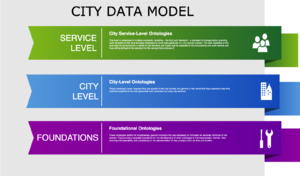City Data Model
A common data model enables city software applications to share information, plan, coordinate, and execute city tasks, and support decision making within and across city services, by providing a precise, unambiguous representation of information and knowledge commonly shared across city services. This requires a clear understanding of the terms used in defining the data, as well as how they relate to one another. This requirement goes beyond syntactic integration (e.g. common data types and protocols), it requires semantic integration: a consistent, shared understanding of the meaning of information.
The City Data Model is stratified into three levels of abstraction (pictured below). The Foundation Level covers very general concepts such as Time, Location, and Activity. The City Level covers concepts that are general to cities and span all services such as Households, Services, Residents. The Service Level spans concepts commonly associated with a particular service but still shared with other services, such as Vehicles and Transportation network.
